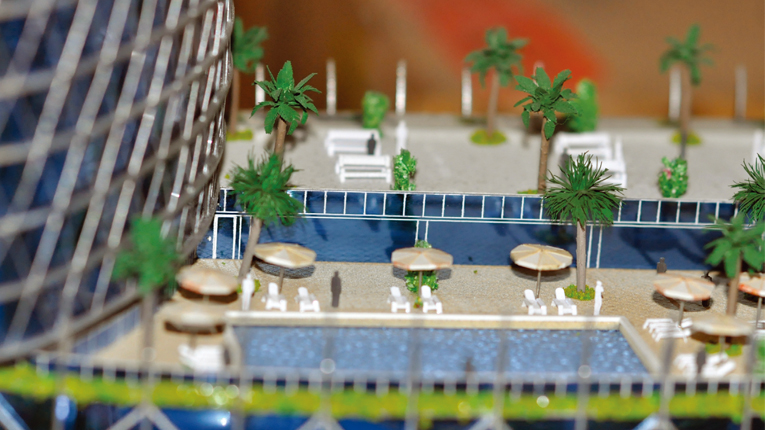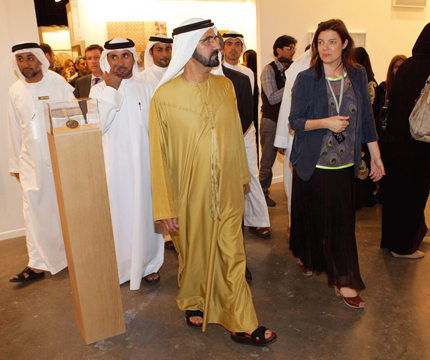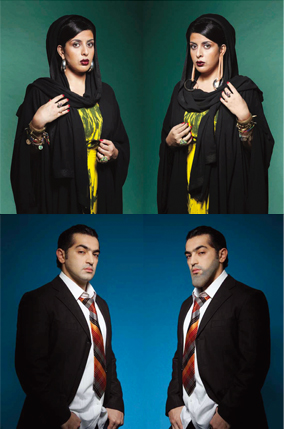DEALING WITH THE DESERT: CONTEMPORARY DUBAI
| June 25, 2012 | Post In LEAP 15

APROPOS THE ART world, Dubai in many ways mirrors Hong Kong. Both are post-colonial waterfront cities that boast histories centuries-long, but have only come to full maturation within the last few decades— Dubai after the establishment of the UAE, Hong Kong after Opening and Reform— and for the most part, they have been perceived as little more than financial petri dishes, home to nothing but banks, malls, and hotels— hardly conduits to cultural production. Neither has made a name as a hotbed for creative practice, but in the last few years and quickly under the free-market sway of their respective international art fairs, both have come to be essential ports of call for the year-round trade of contemporary art. But whereas Hong Kong— and other epicenters like New York or Berlin— favors a more cosmopolitan-minded class of exchange, Dubai’s artistic inclinations remain highly regional in nature, a distinction that has begun to transform the city from cultural desert to cultural oasis, a refreshing stop on contemporary art’s increasingly identikit international silk road.
Dubai’s cityscape is an extraterrestrial desert urbanity, ecologically impossible, an eerie armada of shimmering silver skyscrapers that jut from the sand like swords and are separated into clusters by dusty expanses of Indian restaurants, car dealerships, and luxury serviced apartments. These dot massive four-lane highways, which further demarcate the layout into industry-specific districts: Dubai Media City, Dubai Internet City, Business Bay, Dubai Maritime City, and so on. Unlikely scattered among these are the four primary nodes of the city’s artistic ecosystem: Al Quoz, Alserkal Avenue, Dubai International Financial Centre (DIFC), and Al Bastakiya. Like the aforementioned economic zones, these areas also possess distinct façades: industrial, financial, traditional. It is in these areas that Dubai’s status as a primary destination for the exhibition and acquisition of contemporary art emerges, via the MENASA (Middle East/North Africa/South Asia) region’s most concentrated settlement of galleries and art organizations.
“Dubai brings together the microcosms of the niche art scenes of the region,” says Farah Kaysi of The Third Line, one of city’s more prominent galleries. “As Dubai is expanding rapidly and establishing itself as the cosmopolitan ambassador of the Gulf Cooperation Coucil, not only is it attracting and generating international business, it is also the torchbearer of the cultural scene.” When Dubai first began to bleep on global art radar— roughly in 2007, with the inaugural edition of Art Dubai— there were only five or six spaces operating within the city limits. Among these were Majlis, Green Art Gallery, and Courtyard, all of whom have had a marked predilection for the work of local, Emirati artists. Come 2005, The Third Line and Gallery Isabelle van den Eynde, whose rosters boast several of the region’s more celebrated artists, opened their doors. In the subsequent years, Dubai’s gallery ranks swelled with the likes of Ayyam Gallery, Cuadro, and Artspace— all in the commercial-leaning DIFC, where Christie’s has also maintained a storefront since its first auction in the Middle East 2006— and with only a few exceptions, the peddling has been indubitably regionalized: exhibitions of Emirati, Iranian, Lebanese, Moroccan, Egyptian, Indian, Pakistani, and other ethnically Arab or Farsi artists are the norm in most all of the above-mentioned spaces. This multinational, multilingual mishmash has spurred the rise of over 50 contemporary art galleries, institutions, and project spaces that call Dubai home at current. Some of the more notable entries are to be found in greater Al Quoz with The Third Line, Meem, and Traffic, and among the 20-some warehouses in freshly-minted Alserkal Avenue: the Iranian collector Ramin Salsali’s Salsali Private Museum, the joint collaboration between the former director of contemporary Middle Eastern at Christie’s and the former managing director of Art Dubai Lawrie Shabibi, and the newest talk of the town, the conceptual-leaning Grey Noise, formerly of Lahore, Pakistan. This upsurge, no matter how large or small, cannot be considered without observing the ripples from the growing Art Dubai.

The Gulf region’s first and only major art fair has been lauded, especially after the handover of Art HK to Basel, as the last man standing to not have completely sold out to the Western-centric model currently dominating other annual venues. The persistence of the fair’s local flavor may be in part explained by the Patronage of HH Sheikh Mohammed bin Rashid Al Maktoum, Vice-President and Prime Minister of the UAE, Ruler of Dubai, whose interests are clearly vested in local industries (there are rumors that the Sheikh acquired all unsold artworks after the closing of previous editions, which would help to explain the enthusiastic return of so many dealers— even post-2008 credit crunch, which otherwise hit the emirate harder than it did its oil-dependent neighbors). In 2012, more than 22,000 people— including 75 international museum groups, a fact on which fair promotion laid particular stress— visited the booths of Art Dubai’s 70-plus galleries.
Although there were a considerable number of non-MENASA attendees to be noted among the crowd— including some of the international art world’s most sought-after figures, many on the ticket for the fair’s amusingly self-aware, meta-academic Global Art Forum and other satellite presentations and performances— the brokering was done in an unmistakable patois. The majority of the participating galleries hailed from the region, and even at those who didn’t, the artwork did too. Perhaps in reflection of the often loud and vivacious palettes of the pieces on hand— sellers and buyers in Dubai seem to gravitate towards opulent use of color and language— the atmosphere was decidedly buoyant, and although the casual observer couldn’t immediately infer sell-through rates, she might have discerned a sense of indomitable will: Here you are witnessing an entirely self-sufficient art world, growingly proficient in its own market and discourse.

One visible catalyst of this confidence in regional productivity is the “world’s most generous art prize,” the Abraaj Capital Prize, bestowed annually and with pomp by “the largest private equity firm in emerging markets worldwide” to MENASA-only artists during the fair’s duration. The prestige that comes with the title seems to transcend the USD 1 million purse, as past winners have found easy paths to success— several of them were flaunted at Art Dubai 2012— and hopeful winners purportedly number in the hundreds. No matter how mouth-wateringly motivating this princely sum proves for artists in the area, questions remain as to why only a handful of artists on display at Art Dubai, as well as on the rosters of local galleries, are actually based in Dubai. Granted, there were Emirati artists— for example, “the founding father of UAE art” Hassan Sharif, who was tellingly and finally given face at the 2012 edition— and there is indeed a growing number of emerging names who call Dubai home— like the anonymous UBIK and the American James Clar, both of whom were commissioned to make site-specific creations— but the city has yet to prove itself propitious to artistic practice. Speculation would place blame for this on any number of factors, but the answer is empirically elusive. Regardless, several initiatives are working to reverse this truth. Tashkeel and thejamjar are organizations, loosely built on the gallery model, that aim to provide the physical tools, education, and opportunity for local artists to develop, while Sikka is a small artist-run fair— underwritten by the state-run Dubai Culture and Arts Authority, which is also plotting to add another arts node to the city in the Dubai Creek area— that attempts to expose the rawer, creative underbelly of the city during Art Dubai. At the latter, visitors are bound to discover young artists fresh out of the academy (most in neighboring Sharjah), exciting less for their work per se than for how that work confronts their circumstances. From their accent-less international-school English, one assumes that their talents were born of overly-privileged backgrounds, but from their fierce sense of concern with the region’s history, society, language, and so on, one assumes that they are nonetheless genuinely passionate practitioners of art.
Yet the careers of these few young local artists are much too embryonic for observers to make any conclusion about art’s ecological trajectory in Dubai; the commercial arm of the system remains a much better gauge. According to Grey Noise’s director Umer Butt, “The Middle East, specifically the U.A.E., is a new entry in the contemporary art market. It is obviously learning from various art movements and events and I don’t see any harm in that. Besides, currently the Dubai art gallery circuit is progressing beyond ‘The Middle Eastern Art Promoter.’ Proof of which is evident at a variety of art galleries around the city. We live in the Google World; the idea of regional debate has moved on to a much wider context.”
This wider context may be discerned at, say, Art Dubai’s Global Art Forum, but perhaps not so much within the city’s exhibition and fair programming. Dubai is still the champion of a region that panders less to the homologous, cosmopolitan models that may have fostered cities like Hong Kong. Dubai might with open arms welcome a Gagosian or a White Cube in the future, but for now, its own advancement has proudly allowed regionalist aplomb, and therein lies the reason its art scene has been able to flourish amidst its desert confines.


